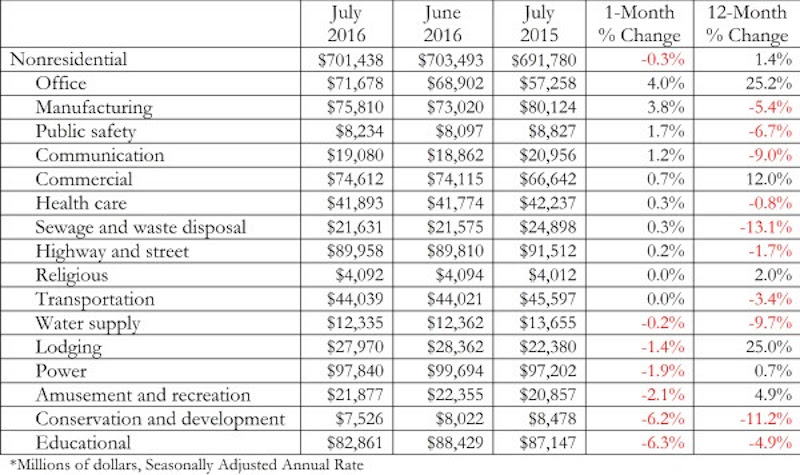Nonresidential construction spending inched 0.3 percent lower in July largely due to a significant upward revision to June’s spending figure, according to analysis of U.S. Census Bureau data released today by Associated Builders and Contractors (ABC). Nonresidential spending totaled $701.4 billion on a seasonally adjusted annualized basis in July, the second highest month since November of 2008, right behind June, which was revised upward from $682 billion to $703.5 billion. Public nonresidential spending continued to falter, declining 3.2 percent for the month and 6.5 percent for the year.
Nonresidential construction spending has been suppressed over the last year or so with the primary factor being the lack of momentum in public spending. “This lack of public investment continues despite obvious deficiencies in water, road and other forms of infrastructure. The fact that all but two of the 12 public nonresidential public subsectors declined in July shows that the malaise is widespread,” says ABC Chief Economist Anirban Basu in a press release.
The second biggest factor deals with tightening commercial real estate standards that may have been brought on by growing regulatory pressures. “There is growing concern that key commercial real estate segments are in the process of being overbuilt, particularly in America’s largest cities, which are most likely to attract significant levels of foreign investment,” Basu says.
All is not negative, however, as the housing sector has begun to improve at a meaningful rate and the country continues to add a substantial number of jobs. Additionally, interest rates remain low.

Related Stories
Market Data | May 18, 2022
Architecture Billings Index moderates slightly, remains strong
For the fifteenth consecutive month architecture firms reported increasing demand for design services in April, according to a new report today from The American Institute of Architects (AIA).
Market Data | May 12, 2022
Monthly construction input prices increase in April
Construction input prices increased 0.8% in April compared to the previous month, according to an Associated Builders and Contractors analysis of U.S. Bureau of Labor Statistics’ Producer Price Index data released today.
Market Data | May 10, 2022
Hybrid work could result in 20% less demand for office space
Global office demand could drop by between 10% and 20% as companies continue to develop policies around hybrid work arrangements, a Barclays analyst recently stated on CNBC.
Market Data | May 6, 2022
Nonresidential construction spending down 1% in March
National nonresidential construction spending was down 0.8% in March, according to an Associated Builders and Contractors analysis of data published today by the U.S. Census Bureau.
Market Data | Apr 29, 2022
Global forces push construction prices higher
Consigli’s latest forecast predicts high single-digit increases for this year.
Market Data | Apr 29, 2022
U.S. economy contracts, investment in structures down, says ABC
The U.S. economy contracted at a 1.4% annualized rate during the first quarter of 2022.
Market Data | Apr 20, 2022
Pace of demand for design services rapidly accelerates
Demand for design services in March expanded sharply from February according to a new report today from The American Institute of Architects (AIA).
Market Data | Apr 14, 2022
FMI 2022 construction spending forecast: 7% growth despite economic turmoil
Growth will be offset by inflation, supply chain snarls, a shortage of workers, project delays, and economic turmoil caused by international events such as the Russia-Ukraine war.
Industrial Facilities | Apr 14, 2022
JLL's take on the race for industrial space
In the previous decade, the inventory of industrial space couldn’t keep up with demand that was driven by the dual surges of the coronavirus and online shopping. Vacancies declined and rents rose. JLL has just published a research report on this sector called “The Race for Industrial Space.” Mehtab Randhawa, JLL’s Americas Head of Industrial Research, shares the highlights of a new report on the industrial sector's growth.
Codes and Standards | Apr 4, 2022
Construction of industrial space continues robust growth
Construction and development of new industrial space in the U.S. remains robust, with all signs pointing to another big year in this market segment

















